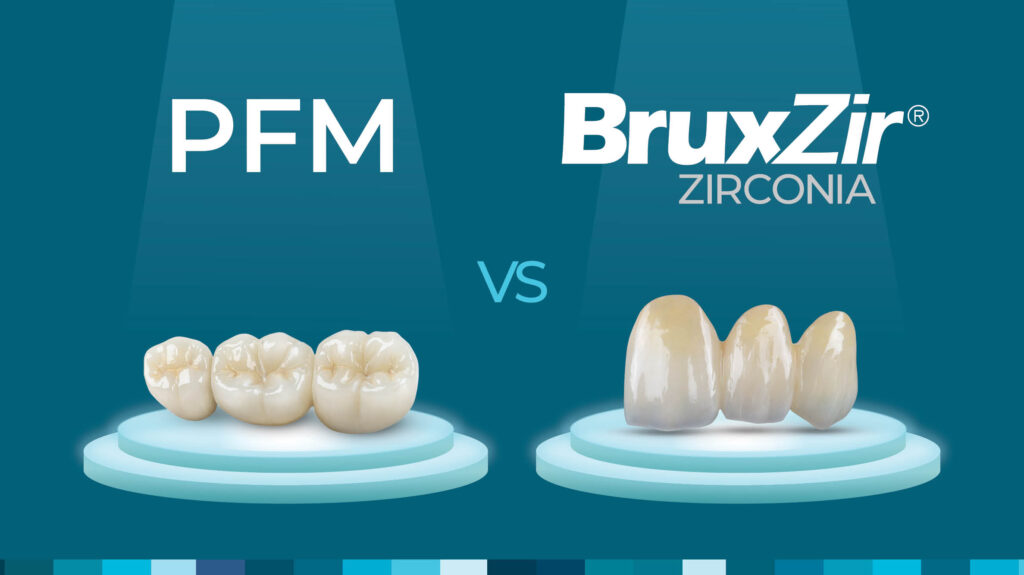Implant crowns are a wonder of dentistry, used to replace missing or damaged teeth for millions across the world. But there’s a few options to choose from, with a variety of materials that differ in durability and aesthetics.
In this article, we explore the most common types of implant crowns, so that you can choose the crown that is right for you.
What Are Implant Crowns?
An implant crown is an artificial tooth that is fixed to the jaw or cheekbone, which gives it the strength and durability of a regular tooth. Once fitted, an implant crown connects to the bone through a process called osseointegration, whereby new bone cells grow around the screw-like “post” and keep the crown secure. This is illustrated in the image below.

What Are Zirconia Crowns?
Solid crowns are considered the gold standard, and provide a great combination of aesthetics (the crown is the same white hue all the way through) & strength (a very durable and hard wearing material) that is desirable for both the patient and dentist alike.
Solid zirconia crowns are best used at the back of the mouth (premolar & molar regions). The zirconia material is white & comes in a number of shades but is lacking the more natural translucency of human teeth.
Therefore, when zirconia is used for the front teeth (incisors & canines) the material will be resurfaced (veneered) with a more translucent version of zirconia to make for a more natural appearance to the teeth.
The translucent zirconia whilst less durable than the solid zirconia, is supported with a framework of solid zirconia. The veneered (translucent + solid zirconia) crown makes for a very aesthetically pleasing crown, as more light is able to pass through them which makes them look closer to natural teeth, which makes them ideal for anterior (front) teeth.
Zirconia also doesn’t react with chemicals in the same way that metals do, which reduces the risk of allergic reactions.
What Are IPS e.max Crowns?
IPS e.max crowns are dental restorations made from lithium disilicate, a glass-ceramic material that’s composed of quartz, lithium dioxide, phosphor oxide, alumina, potassium oxide and other components. This combination results in crowns with excellent esthetics that are simple to use in the dental practice. What’s more, according to Ivoclar Vivadent, IPS e.max is the world’s best-selling glass-ceramic dental material.1 IPS e.max lithium disilicate can be used for single-unit restorations as well as anterior bridges up to 3 units.
- Continue to maintain your usual oral hygiene routine to ensure that the surrounding temporary crown is clean
- Gently floss to remove food particles stuck between teeth
- When brushing your teeth, brush your teeth in the area where the crown is attached slowly and gently
Clinical Performance
When comparing the performance of monolithic ceramic materials, the most commonly discussed characteristic is flexural strength.
Flexural strength is a measure of a material’s ability to withstand an impacting force prior to breaking. In a clinical setting, this influences how much bite stress can be applied to a crown before failure. Flexural strength also influences a material’s ability to be made into long-span bridges as well as the overall wall thickness of the final restoration. Ceramic materials with greater flexural strength typically support versatility and minimally invasive dentistry.2
While zirconia crowns are stronger, both BruxZir and IPS e.max restorations have demonstrated excellent performance in a 10-year independent clinical study. In the study published by the Gordon J. Christensen Clinicians Report®, 100% of BruxZir Full-Strength crowns and 94% of IPS e.max crowns survived after 10 years of clinical service.5 Both options represent a substantial strength and performance increase over the PFM restorations that have been commonly used in dentistry during the last few decades.
Appearance
One of the biggest challenges in restorative dentistry is precisely matching a ceramic restoration to the surrounding natural dentition. To help dentists, material manufacturers have gone to great lengths to develop options that exhibit light transmission, reflection and color characteristics similar to real teeth, with each generation of restorative material offering improved appearances. Zirconia and IPS e.max crowns represent the latest generation of restorative materials available in dentistry, and they both benefit from advanced manufacturing techniques.
Over the last decade in dentistry, IPS e.max crowns have been widely recognized as some of the most beautiful monolithic ceramic restorations available. They have a coloration and translucency that closely matches those of natural dentition. As a result, IPS e.max crowns are used very commonly for treatment in the smile zone.
As a byproduct of their high-strength composition, zirconia crowns allow for less light transmission than their lithium disilicate counterparts. The reduced light transmission results in a less vital-looking restoration. While their zirconia composition does impact the overall appearance, this has been addressed substantially in recent years. The full-strength zirconia crowns of today exhibit an enhanced appearance compared to the original monolithic zirconia restorations released in 2009. And, when compared to many other zirconia crown brands, BruxZir Full-Strength crowns have enhanced optical properties thanks to their patented composition. Still, zirconia crowns are most commonly used for treatment in the posterior of the mouth.
Recently, an additional class of zirconia crown has been introduced that offers an even more improved appearance while still maintaining substantial strength. At Glidewell, we offer BruxZir Esthetic, which has more true-to-life coloration and translucency characteristics than classic full-strength zirconia. First launched in 2018, BruxZir Esthetic crowns are quickly becoming a favorite among dentists for anterior cases.
Our Service
- Zirconia Crown and Bridge
- Full Arch Restoration